Ballistics
The term ballistics refers to the science of the travel of a projectile in
flight. The flight path of a bullet includes: travel down the barrel, path
through the air, and path through a target. The wounding potential of projectiles is a complex matter. (Fackler, 1996)
Internal, or initial ballistics (within the gun)
Bullets fired from a rifle will have more energy than similar bullets fired from a handgun. More powder can also be used in rifle cartridges because the bullet chambers can be designed to withstand greater pressures (70,000 psi vs. 40,000 psi for handgun chamber). It is difficult in practice to measure the forces within a gun barrel, but the one easily measured parameter is the velocity with which the bullet exits the barrel (muzzle velocity) and this is what will be used in examples below. The controlled expansion of burning gunpowder generates pressure (force/area). The area here is the base of the bullet (equivalent to diameter of barrel) and is a constant. Therefore, the energy transmitted to the bullet (with a given mass) will depend upon mass times force times the time interval over which the force is applied. The last of these factors is a function of barrel length. Bullet travel through a gun barrel is characterized by increasing acceleration as the expanding gases push on it. Up to a point, the longer the barrel, the greater the acceleration.

External ballistics (from gun to target)
The external ballistics of a bullet's path can be determined by several formulae, the simplest of which is:
Kinetic Energy (KE) = 1/2 MV2 Velocity (V) is usually given in feet/second (fps) and mass (M) is
given in pounds, derived from the weight (W) of the bullet in grains, divided by
7000 grains per pound times the acceleration of gravity (32 ft/sec) so that:
Kinetic Energy (KE) = (WV)2 / (450,435) ft/lb This is the bullet's energy as it leaves the muzzle, but the ballistic
coefficient (BC) will determine the amount of KE delivered to the target as air
resistance is encountered.
Ballistic coefficient (BC) = SD / I SD is the sectional density of the bullet, and I is a form factor for the bullet shape. Sectional density is calculated from the bullet mass (M) divided by the square of its diameter. The
form factor value I decreases with increasing pointedness of the bullet (a sphere would have the highest I value). Forward motion of the bullet is also affected by drag (D), which is calculated as:
Drag (D) = f(v/a)k&pd2v2
f(v/a) is a coefficient related to the ratio of the velocity of the
bullet to the velocity of sound in the medium through which it travels. k is a
constant for the shape of the bullet and & is a constant for yaw (deviation
from linear flight). p is the density of the medium (tissue density is >800
times that of air), d is the diameter (caliber) of the bullet, and v the
velocity. Thus, greater velocity, greater caliber, or denser tissue gives more
drag. The degree to which a bullet is slowed by drag is called retardation (r)
given by the formula:
r = D / M
Since drag (D) is a function of velocity, it can be seen that for a bullet
of a given mass (M), the greater the velocity, the greater the retardation.
Drag is also influenced by bullet spin. The faster the spin, the less likely a
bullet will "yaw" or turn sideways and tumble. Thus, increasing the
twist of the rifling from 1 in 7 will impart greater spin than the typical 1 in
12 spiral (one turn in 12 inches of barrel).
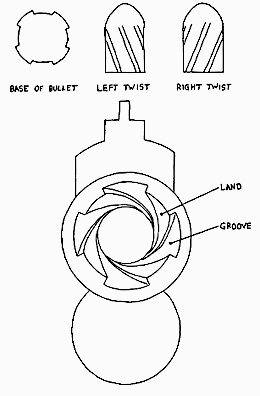
Bullets do not typically follow a straight line to the target. Rotational forces are in effect that keep the bullet off a straight axis of flight. These rotational effects are diagrammed below:

What do all these formulae mean in terms of designing cartridges and
bullets? Well, given that a cartridge can be only so large to fit in a chamber,
and given that the steel of the chamber can handle only so much pressure from
increasing the amount of gunpowder, the kinetic energy for any given weapon is
increased more easily by increasing bullet mass. Though the square of the
velocity would increase KE much more, it is practically very difficult to
increase velocity, which is dependent upon the amount of gunpowder burned.
There is only so much gunpowder that can burned efficiently in a cartridge.
Thus, cartridges designed for hunting big game animals use very large bullets. To reduce air resistance, the ideal bullet would be a long, heavy
needle, but such a projectile would go right through the target without
dispersing any of its energy. Light spheres would be retarded the greatest and
release more energy, but might not get to the target. A compromise for a good
aerodynamic shape is a parbolic curve with low frontal area and wind-splitting
shape. The best bullet composition is lead (Pb) which is of high density and is
cheap to obtain. Its disadvantages are a tendency to soften at velocities >1000 fps, causing it to smear the barrel and decrease accuracy, and >2000 fps lead tends to melt completely. Alloying the lead (Pb) with a small amount of antimony (Sb) helps, but the real answer is to interface the lead bullet with
the barrel through another metal soft enough to seal the bullet in the barrel
but of high melting point. Copper (Cu) works best as this "jacket"
material for lead.
Terminal ballistics (hitting the target)
Tumbling has a lot to do with the injury pattern of a bullet on
the target, termed "terminal ballistics." A short, high velocity
bullet begins tumbling more rapidly in tissue. This causes more tissue to be
displaced and imparts more of the KE to the target. A longer, heavier bullet
might have more KE at a longer range when it hits the target, but it may
penetrate so well that it exits the target with much of its KE remaining. Even
a bullet with a low KE can impart significant tissue damage if it can be
designed to give up all of the KE into the target, and the target is at short
range (as with handguns).
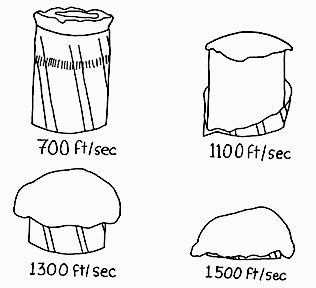
Bullets produce tissue damage in three ways (Bartlett, 2003):
Laceration and crushing - Low velocity bullets, as in handguns, that
travel less than 1000 fps do virtually all their damage via crushing. Cavitation - Cavitation is significant with projectiles travelling in
excess of 1000 fps. A "permanent" cavity is caused by the path of the
bullet itself, whereas a "temporary" cavity is formed by continued
forward acceleration of the medium (air or tissue) in the wake of the bullet,
causing the wound cavity to be stretched outward.
Shock waves - Shock waves compress the medium and travel ahead of the
bullet, as well as to the sides, but these waves last only a few microseconds
and do not cause profound destruction at low velocity. At high velocity,
generated shock waves can reach up to 200 atmospheres of pressure. (DiMaio and Zumwalt, 1977) However, bone fracture from cavitation is an extremely rare event. (Fackler, 1996) The mathematics of wound ballistics, in reference to yaw of unstable projectiles, has been described. The model works well for non-deformable bullets. (Peters et al, 1996)(Peters and Sebourn, 1996) The following images illustrate bullet deformation and damage:
Bullet velocity and mass will affect the nature of wounding. Velocity
is classified as low (<1000 fps), medium (1000 to 2000 fps), and high (>2000
fps). (Wilson, 1977) An M-16 rifle (.223 cal) is designed to produce large
surface wounds with high velocity, low mass bullets that tumble, cavitate, and
release energy quickly. A hunting rifle (.308 cal or greater) would have a
larger mass bullet to penetrate a greater depth to kill a large game animal at a
distance. Bullet design is important in wounding potential. The Hague Convention
of 1899 (and subsequently the Geneva Convention) forbade the use of expanding,
deformable bullets in wartime. Therefore, military bullets have full metal
jackets around the lead core. Of course, the treaty had less to do with
compliance than the fact that modern military assault rifles fire projectiles at
high velocity (>2000 fps) and the bullets need to be jacketed with
copper, because the lead begins to melt from heat generated at speeds >2000
fps. However, police departments, hunters, and assorted "bad guys"
did not sign the treaty and may use low velocity handgun cartridges with bullets
having a soft lead point or a "hollowpoint" designed specifically to
deform on impact. Such deformation imparts all the KE of the bullet to the
tissues in a short distance. Bullet shapes are diagrammed below:
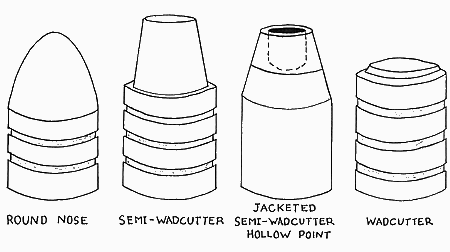
The distance of the target from the muzzle plays a large role in
wounding capacity, for most bullets fired from handguns have lost significant KE
at 100 yards, while high-velocity military .308 rounds still have considerable
KE even at 500 yards. Military and hunting rifles are designed to deliver
bullets with more KE at a greater distance than are handguns and shotguns. The type of tissue affects wounding potential, as well as the depth of
penetration. (Bartlett, 2003) Specific gravity (density) and elasticity are the
major tissue factors. The higher the specific gravity, the greater the damage.
The greater the elasticity, the less the damage. Thus, lung of low density and
high elasticity is damaged less than muscle with higher density but some
elasticity. Liver, spleen, and brain have no elasticity and are easily injured,
as is adipose tissue. Fluid-filled organs (bladder, heart, great vessels,
bowel) can burst because of pressure waves generated. A bullet striking bone
may cause fragmentation of bone and/or bullet, with numerous secondary missiles
formed, each producing additional wounding. The speed at which a projectile must travel to penetrate skin is 163
fps and to break bone is 213 fps, both of which are quite low, so other factors
are more important in producing damage. (Belkin, 1978) Designing a bullet for efficient transfer of energy to a particular
target is not straightforward, for targets differ. To penetrate the thick hide
and tough bone of an elephant, the bullet must be pointed, of small diameter,
and durable enough to resist disintegration. However, such a bullet would
penetrate most human tissues like a spear, doing little more damage than a knife
wound. A bullet designed to damage human tissues would need some sort of "brakes" so that all the KE was transmitted to the target. It is easier to design measures to aid deceleration of a larger, slower
moving bullet in tissues than a small, high velocity bullet. Such measures
include shape modifications like round (round nose), flattened (wadcutter), or
cupped (hollowpoint) bullet nose. Round nose bullets provide the least braking,
are usually jacketed, and useful mostly in low velocity handguns. The wadcutter
design provides the most braking from shape alone, is not jacketed, and is used
in low velocity handguns (often for target practice). A semi-wadcutter design
is intermediate between the round nose and wadcutter and is useful at medium
velocity. Hollowpoint bullet design facilitates turning the bullet "inside
out" and flattening the front, referred to as "expansion."
Expansion reliably occurs only at velocities exceeding 1200 fps, so is suited
only to the highest velocity handguns. Wounding is an extremely complex situation with variables of bullet
size, velocity, shape, spin, distance from muzzle to target, and nature of
tissue. These factors are interrelated, and the wounding potential may be
difficult to predict even under controlled test conditions. In an actual
forensic case, few of the variables may be known, and it is up to the medical
examiner to determine what can be known from examination of the evidence. The best approach to wound care is conservative. With simple punctures and no apparent tissue disruption, just irrigation and application of a dressing may suffice. So-called "high velocity" rounds are not necessarily more damaging because they are jacketed and the bullet is smaller in size. Variability in wounding from such rounds is often a function of bullet yaw. A fully jacketed 7.62 mm military round creates a much smaller temporary and permanent cavity in tissue than a 7.62 mm civilian "hunting" round with a soft point tip, despite the fact that both are "high velocity" rounds. Treatment guidelines include the use of antibiotics if necessary, and debridement of devitalized tissues when greater tissue disruption is apparent. It can be difficult to determine the extent of disruption and the amount of non-viable tissue, so reassessment of more disruptive wounds left open for 48 hours can be done. In short, "treat the wound, not the weapon." (Fackler, 1996)(Fackler, 1998) In a study by Ordog et al, 1993 wound irrigation and a dressing were required in 79% of 3316 gunshot wounds, while only 1% required local wound debridement and 2% required exploration and removal of the missile. In 40% of cases, antibiotic therapy was used, and 34% of victims were given tetanus prophylaxis. In only 1.8% of cases did a wound infection develop. Predictors of infection included: a delay in treatment, gross wound contamination, significant tissue devitalization, large wound size, and multiple gunshot wounds. The use of duplex doppler ultrasonography can aid in determination of the extent of vascular injury, both avoiding missed vascular injuries and reducing unnecessary further testing and observation. (Ordog et al, 1994) Antibiotic prophylaxis is recommended in high-velocity, shotgun, and intraarticular gunshot fractures. The recommendation for high-velocity gunshot or shotgun injuries is intravenous administration of at least 48 hours of a first-generation cephalosporin, with addition of gentamicin in cases of soft tissue defects or cavitary lesions. Penicillin must be added in patients with gross wound contamination. (Simpson et al, 2003) Handgun Ballistics
These weapons are easily concealed but hard to aim accurately,
especially in crime scenes. Most handgun shootings occur at less than 7 yards,
but even so, most bullets miss their intended target (only 11% of assailants'
bullets and 25% of bullets fired by police officers hit the intended target in a
study by Lesce, 1984). Usually, low caliber weapons are employed in crimes
because they are cheaper and lighter to carry and easier to control when
shooting. Tissue destruction can be increased at any caliber by use of
hollowpoint expanding bullets. Some law enforcement agencies have adopted such
bullets because they are thought to have more "stopping power" at
short range. Most handgun bullets, though, deliver less than 1000 ft/lb of KE.
(Ragsdale, 1984) However, there is a myth, kept alive by portrayals of shooting victims on television and in films being hurled backwards, that victims are actually "knocked down" or displaced by being struck with the force of a bullet. In fact, real gunshot victims relate that they had no immediate reaction. (Fackler, 1998) The maximum momentum transferred from different small arms projectiles, inluding large caliber rifles and shotguns, to an 80 kg body is only 0.01 to 0.18 m/s, negligible compared to the 1 to 2 m/s velocity of a pedestrian. (Karger and Knewbuehl, 1996) Incapacitation of gunshot victims is primarily a function of the area of the body wounded. Immediate incapacitation may occur with gunshot wounds to the brain and upper cervical cord. Rapid incapacitation may occur with massive bleeding from major blood vessels or the heart. (Karger, 1995) The two major variables in handgun ballistics are diameter of the
bullet and volume of gunpowder in the cartridge case. Cartridges of older
design were limited by the pressures they could withstand, but advances in
metallurgy have allowed doubling and tripling of the maximum pressures so that
more KE can be generated. Many different cartridges are available using different loads and bullet designs. Some of these are outlined in the table below to compare and contrast the ballistics.
|
 Return to the Firearms Tutorial menu.
Return to the Firearms Tutorial menu. Return to the Firearms Tutorial menu.
Return to the Firearms Tutorial menu. Return to Anatomy of Firearms.
Return to Anatomy of Firearms.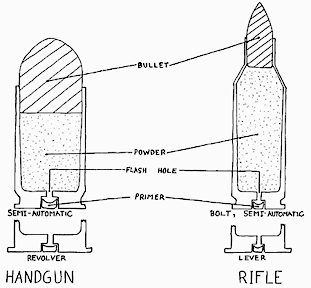
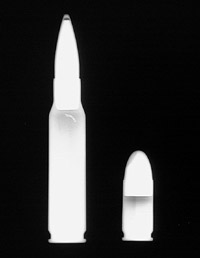

 Proceed to Patterns of Tissue Injury.
Proceed to Patterns of Tissue Injury.